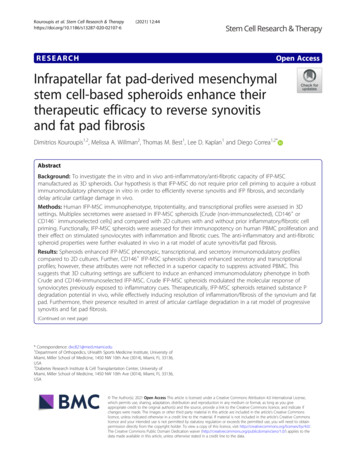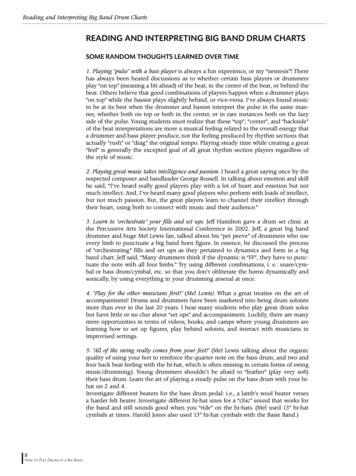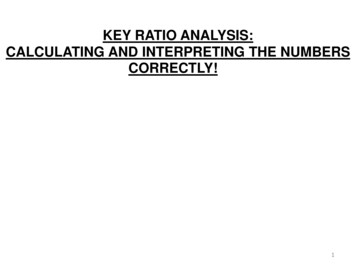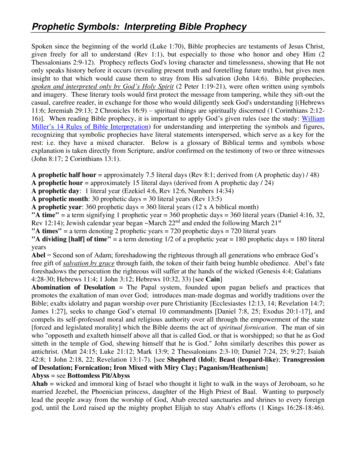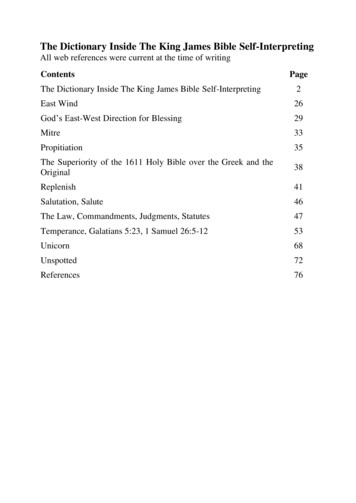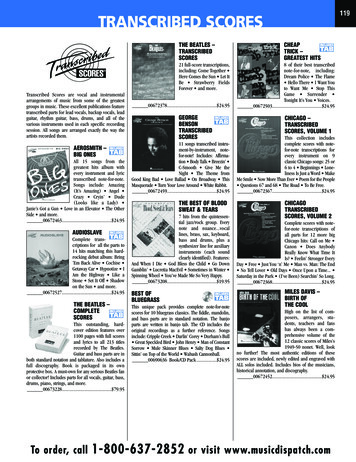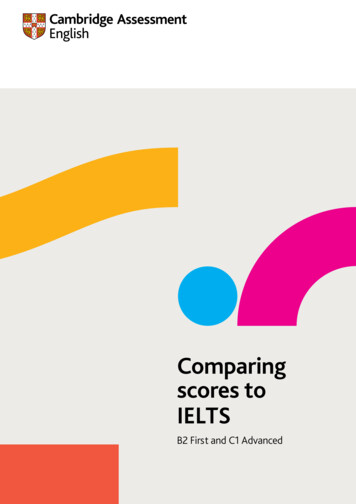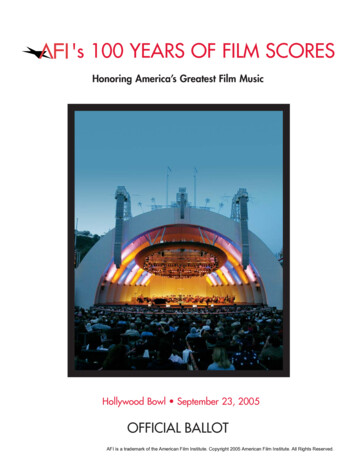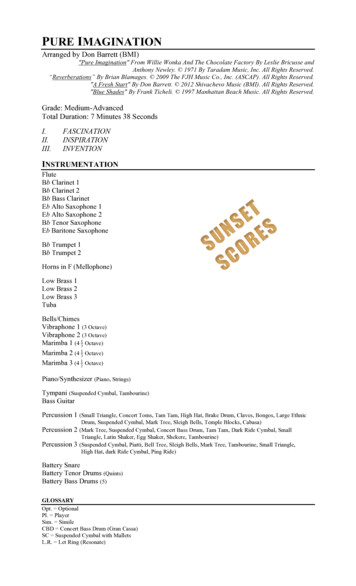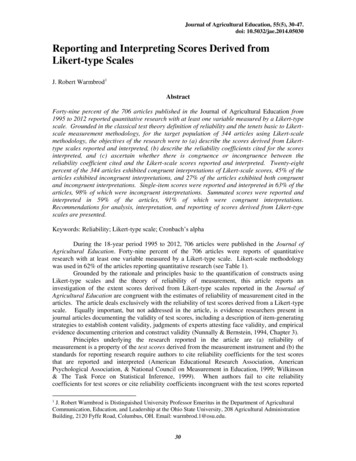
Transcription
Journal of Agricultural Education, 55(5), 30-47.doi: 10.5032/jae.2014.05030Reporting and Interpreting Scores Derived fromLikert-type ScalesJ. Robert Warmbrod1AbstractForty-nine percent of the 706 articles published in the Journal of Agricultural Education from1995 to 2012 reported quantitative research with at least one variable measured by a Likert-typescale. Grounded in the classical test theory definition of reliability and the tenets basic to Likertscale measurement methodology, for the target population of 344 articles using Likert-scalemethodology, the objectives of the research were to (a) describe the scores derived from Likerttype scales reported and interpreted, (b) describe the reliability coefficients cited for the scoresinterpreted, and (c) ascertain whether there is congruence or incongruence between thereliability coefficient cited and the Likert-scale scores reported and interpreted. Twenty-eightpercent of the 344 articles exhibited congruent interpretations of Likert-scale scores, 45% of thearticles exhibited incongruent interpretations, and 27% of the articles exhibited both congruentand incongruent interpretations. Single-item scores were reported and interpreted in 63% of thearticles, 98% of which were incongruent interpretations. Summated scores were reported andinterpreted in 59% of the articles, 91% of which were congruent interpretations.Recommendations for analysis, interpretation, and reporting of scores derived from Likert-typescales are presented.Keywords: Reliability; Likert-type scale; Cronbach’s alphaDuring the 18-year period 1995 to 2012, 706 articles were published in the Journal ofAgricultural Education. Forty-nine percent of the 706 articles were reports of quantitativeresearch with at least one variable measured by a Likert-type scale. Likert-scale methodologywas used in 62% of the articles reporting quantitative research (see Table 1).Grounded by the rationale and principles basic to the quantification of constructs usingLikert-type scales and the theory of reliability of measurement, this article reports aninvestigation of the extent scores derived from Likert-type scales reported in the Journal ofAgricultural Education are congruent with the estimates of reliability of measurement cited in thearticles. The article deals exclusively with the reliability of test scores derived from a Likert-typescale. Equally important, but not addressed in the article, is evidence researchers present injournal articles documenting the validity of test scores, including a description of item-generatingstrategies to establish content validity, judgments of experts attesting face validity, and empiricalevidence documenting criterion and construct validity (Nunnally & Bernstein, 1994, Chapter 3).Principles underlying the research reported in the article are (a) reliability ofmeasurement is a property of the test scores derived from the measurement instrument and (b) thestandards for reporting research require authors to cite reliability coefficients for the test scoresthat are reported and interpreted (American Educational Research Association, AmericanPsychological Association, & National Council on Measurement in Education, 1999; Wilkinson& The Task Force on Statistical Inference, 1999). When authors fail to cite reliabilitycoefficients for test scores or cite reliability coefficients incongruent with the test scores reported1J. Robert Warmbrod is Distinguished University Professor Emeritus in the Department of AgriculturalCommunication, Education, and Leadership at the Ohio State University, 208 Agricultural AdministrationBuilding, 2120 Fyffe Road, Columbus, OH. Email: warmbrod.1@osu.edu.30
WarmbrodReporting and Interpreting Scoresand interpreted, evidence documenting the accuracy of measurement for the variables beinginvestigated is unknown, thereby violating a basic standard for reporting educational andpsychological test results.Table 1Articles Published in the Journal of Agricultural Education: 1995 – 2012No. ofarticles% of706 articles706100.0Articles reporting non-quantitative researcha15221.5---Articles reporting quantitative research55478.5100.0Articles with no Likert-type scale21029.837.9Articles published: 1995 – 2012Total articles published% of554 articles34448.762.1 Articles with Likert-type scaleAAAE Distinguished Lecture, review and synthesis of research, historical research,philosophical research, content analysis, and qualitative research.aThe Likert ScaleMore than 80 years ago psychologist Rensis Likert published a monograph, A Techniquefor the Measurement of Attitudes, describing the concepts, principles, and substantiative researchbasic to an instrument to quantify constructs describing psychological and social phenomena(Likert, 1932). A Likert-type scale consists of a series of statements that define and describe thecontent and meaning of the construct measured. The statements comprising the scale express abelief, preference, judgment, or opinion. The statements are composed to define collectively anunidimensional construct (Babbie, 1999; McIver & Carmines, 1981). Alternatively, clusters ofstatements within a scale may define one or more subscales that quantify more specificunidemensional subconstructs within the major scale. In designing a Likert scale, the generationand wording of individual statements are crucial tasks for producing an instrument that yieldsvalid and reliable summated scores (Edwards, 1957; Oppenheim, 1992; Spector, 1992).The response continuum for each statement is a linear scale indicating the extentrespondents agree or disagree with each statement. For example, a generic response continuum is1 Strongly Disagree, 2 Disagree, 3 Undecided or Neutral, 4 Agree, and 5 StronglyAgree for statements favorable to the construct. For statements unfavorable to the construct –negatively worded statements – the numerical values for the response options are reversed whenthe summated score for the construct is calculated.Likert’s (1932) monograph specifies that the quantification of the construct is asummated score for each individual calculated by summing an individual’s responses for eachitem comprising the scale. Kerlinger (1986) described a Likert scale as a summated rating scalewhereby an inividual’s score on the scale is a sum, or average, of the individual’s responses to themultiple items on the instrument. Oppenheim (1992), Kline (1998), and Babbie (1999)emphasized that the score an individual receives on a Likert scale is the sum of an individual’sresponses to all items comprising the scale or subscale. A principle basic to Likert scalemeasurement methodology is that scores yielded by a Likert scale are composite (summated)scores derived from an individual’s responses to the multiple items on the scale.Journal of Agricultural Education31Volume 55, Issue 5, 2014
WarmbrodReporting and Interpreting ScoresAn alternative procedure for calculating a composite score for each individual is tocalculate a mean-item summated score, that is, an individual’s summated score divided by thenumber of items constituting the scale or subscale thereby creating a mean-item score for eachindividual that falls within the range of the values for the response continuum options. All itemscomprising a scale or subscale are assumed to have equal weight when calculating a summatedscore or a mean-item score.The content of single items (statements) on a Likert scale collectively define, describe,and name the meaning of the construct quantified by the summated score. When reportingresearch it is appropriate to list the statements that define the unidemensional construct and recordthe percentage of respondents choosing each response option. These summary statistics for eachitem on the scale indicate the content of the construct and the direction and intensity of eachitem’s contribution to the summated total score or summated subscale score.Two basic concepts provide the rationale for reporting and interpreting summated scoresderived from Likert-type scales to quantify psychological, sociological, and educationalconstructs. First is the proposition that the construct being measured is not defined by a singlestatement. A Likert scale is by definition a multiple-item scale. The second definingcharacteristic logically follows: scores derived from a Likert scale are summated scoresdetermined by a composite of responses to multiple items rather than responses to single items.McIver and Carmines (1981), Nunnally and Bernstein (1994), and Oppenheim (1992)contended it is unlikely that a single item can adequately represent a complex underlyingconstruct. Hair, Anderson, Tatham, and Black (1998) emphasized that using responses to a singleitem as representative of a concept runs the risk of potentially misleading results by selecting asingle statement to represent a more complex result. Responses to single items usually have alow degree of relationship with a composite score derived from responses to multiple itemsdefining the construct.Measurement specialists (McIver & Carmines, 1981; Nunnally & Bernstein, 1994)reported that single items tend to be less valid, less accurate, and less reliable than multiple-itemcomposites; that responses to single items have considerable measurement error; and thatsufficient information is rarely available to estimate the accuracy, validity, and reliability of asingle item. The principle of aggregation – the sum of the responses to a set of multiple items is amore stable and unbiased estimate than are responses to any single item in the set – empiricallydemonstrates that summated scores derived from responses to multiple items on a Likert-typescale are more reliable than responses to single items comprising the scale (Rushton, Brainerd, &Pressley, 1983; Strube, 2000). Classical test theory assumes random error is always associatedwith measurement. When responses to the set of single items defining a construct are combined,the random measurement errors tend to average out thereby providing a more reliable compositemeasure of the construct. Blalock’s (1970) investigation of the single-item versus multiple-itemissue concluded with these statements: “With a single measure of each variable, one can remainblissfully unaware of the possibility of measurement error. I see no substitute for the use ofmultiple measures of our most important variables” (p. 111).Researchers in agricultural education use Likert-type scales to measure attitudes aboutpolicies and programs regarding education in and about agriculture; perceptions of barriers,benefits, and challenges to practices and programs; teacher efficacy; job satisfaction; and selfperceptions of level of knowledge and competence. Table 2 lists examples of articles published inthe Journal of Agricultural Education where Likert-type scales were used to quantify constructs.Journal of Agricultural Education32Volume 55, Issue 5, 2014
WarmbrodReporting and Interpreting ScoresTable 2Examples of Constructs Measured in Articles Published in the Journal of AgriculturalEducationExample 1Construct: Teacher Efficacy – Overall efficacy (24 items); Student engagementsubscale (8 items); Instructional strategies subscale (8 items);Classroom management subscale (8 items)Response continuum: How much can you do? 1 Nothing, 3 Very little, 5 Someinfluence, 7 Quite a bit, 9 A great dealTarget population: Agricultural science student teachersExample 2Construct: Attitude toward agriculture (13 items)Response continuum: 0 Strongly disagree, 1 Disagree, 2 Neutral, 3 Agree,4 Strongly agreeTarget population: Secondary school students enrolled in agriscience coursesExample 3Construct: Perception concerning the integration of instruction in science andagriculture (12 items)Response continuum: 1 Strongly disagree, 2 Disagree, 3 Neutral, 4 Agree,5 Strongly AgreeTarget population: Secondary school science teachersThe Concept of ReliabilityReliability describes the accuracy of measurement. Derived from classical test theory,the reliability of a test score that quantifies psychological and social constructs postutlates that anindividual’s true score is comprised of an observed (measured) score minus randon errors ofmeasurement expressed by the the following equation (Cronbach, 1984, Chapter 6).True score Observed score Error(1)Applying this principle when a group of individuals has completed an instrument thatmeasures a specific construct, it follows that the variance of the true scores for the group equalsthe variance of the group’s observed scores minus the variance of the random errors ofmeasurement (see Equation 2).Variance(True score) Variance(Observed score) Variance(Error) (2)When attitudinal and perceptual constructs are measured using Likert-type scales, anindividual’s observed score is a composite summated score, either a summated total score or asummated subscale score, which is the sum of an individual’s responses to items comprising theLikert scale that define the construct being measured. In Equation 2, the variance of the observedsummated scores is calculated for the group of individuals responding to the Likert scale. Thevariance of the errors of measurement, which are assumed to be random, are estimated from theJournal of Agricultural Education33Volume 55, Issue 5, 2014
WarmbrodReporting and Interpreting Scoresvariations among individuals by their responses to each item on the Likert scale. True scores onthe construct being measured for individuals in the group are unknown; therefore, the variance ofthe true summated scores can only be estimated.Reliability is expressed as a coefficient that is the proportion of the variance of theobserved summated scores that is not attributed to random error variance, which is the ratio ofestimated variance of unknown true scores to the calculated variance of the observed scores. Thisratio is depicted in Equation 3.Variance(True scores)Reliability coefficient (3)V
reliability coefficient cited and the Likert-scale scores reported and interpreted. Twenty-eight percent of the 344 articles exhibited congruent interpretations of Likert-scale scores, 45% of the articles exhibited incongruent interpretations, and 27% of the articles exhibited both congruent and incongruent interpretations. Single-item scores were reported and interpreted in 63% of the
